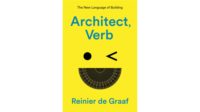Commentary: Is the architect's monograph our latest endangered species?
Like most other architecture critics, I’m often asked to write essays for monographs on living architects. However, unlike some of my colleagues — especially the king of introductions, whom I dub the Grand Old Laureate and Dispenser of Bland Encomiums, Ramblings, and Gallingly Equivocal Reviews — I always decline such requests, even from those whose work I admire and despite the temptingly high honorariums. My blanket excuse is that if I agree to one I’d have to say yes to all, and because the requisite positive introduction is tantamount to a wholesale endorsement, my objectivity would be suspect when assessing the subject’s future designs.

That wariness stems from the fact that no great architect is great every day, or every year, for that matter, and it’s dishonest to pretend otherwise. But whereas the reputations of long-dead titans like Wright and Kahn are so secure that discussing their flaws cannot diminish their standing, current (and lesser) contenders fret that even mild critical reservations might harm their job prospects.
Contrary to the grand posthumous summations that determine artistic rankings, it is customary for monographs about practicing architects to be adulatory to the point of sycophancy. Perhaps the unprobing nature of such productions has had something to do with the steady devaluation of the contemporary architectural monograph. Certainly the Great Recession has been a major factor. Not only is the book-buying public now more cautious in its purchases — what with so much free information instantly available on the Internet — but it is no secret that except for the starriest architects, monographs on contemporary firms are heavily subsidized or wholly underwritten by their subjects, who must agree to buy the lion’s share of a print run or all of it.
Yet in spite of the financial return guaranteed by those terms, several New York publishers have spoken privately of late about drastically reducing the number of architects’ monographs on their lists. (It remains to be seen whether this cutback will include books on Classicists, New Urbanists, and the few remaining aged Modernists who continue to sell in a much-diminished field.)
Were the monograph to disappear completely, it would be a terrible blow to those of us who grew up enraptured by classic self-supervised tomes through which 20th-century masters presented themselves (especially during recessionary periods when underemployed professionals reflexively turn to writing about buildings rather than erecting them). The granddaddy of modern architects’ monographs was Le Corbusier’s Oeuvre complète, an eight-volume series issued between 1929 and 1970, which sequentially chronicled his seminal output in a seemingly objective manner that masked its highly polemical nature.
Corbu’s influential compendiums served as the template for James Stirling: Buildings and Projects, 1950–1974, the wildly popular “Black Book” that mimicked the Oeuvre complète in its horizontal format, mix of monochromatic illustrations with terse copy blocks, and deceptively neutral air of scientific detachment. Quite the opposite in its explosive visual impact and brazen attitudinizing was Rem Koolhaas’s 1996 blockbuster S,M,L,XL, which, with its six-pound doorstop heft and anarchic but compelling layouts (by graphics guru Bruce Mau), reinvented the concept as audaciously as Koolhaas has reconceived urban design itself.
But just as Le Corbusier, Stirling, and Koolhaas are exceptional figures, so their automonographs are hardly representative of what the genre has devolved into — little more than glossy hardcover promotional brochures to entice an uninformed and impressionable lay clientele. To be sure, Corbu hoped to drum up business by the same means, but you don’t have to be in the market for a machine à habiter to find his Oeuvre complète endlessly absorbing more than 80 years after its first installment appeared. In contrast, today’s typically luxurious but vapid overviews — imagine The Collected Houses of Pecksniff + Partners — barely hold one’s interest until the last double-page color spread of a glowing structure at twilight in the snow.
Do the harsh economics of a battered print industry spell inevitable extinction for architects’ monographs? Not necessarily. Doubtless a few diehard firms will keep the vanity-book tradition alive even if they have to issue these seductive sales tools themselves, a task now easier than ever thanks to online programs, though still quite a costly proposition nonetheless. But similar to the way computer-aided design has revolutionized the architectural workplace, the career survey should be radically transformed in the years ahead.
We can surely anticipate far fewer examples from mainstream American architectural publishing houses, which already look to successful cut-rate formulas devised by more-bang-for-the-euro art book presses like Assouline, Taschen, and teNeues for models of how to put out glamorously illustrated editions at a good retail price and healthy profit margin. But all it will take is the emergence of the next once-in-a-generation architectural prodigy for the monograph to suddenly revive, like Snow White awakening from her apple-induced snooze.



